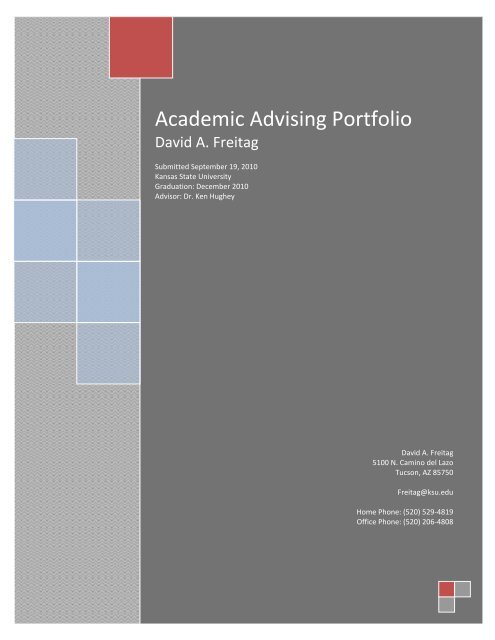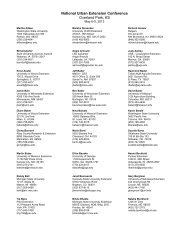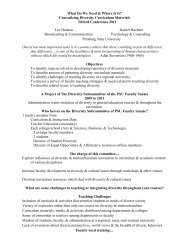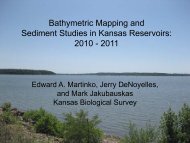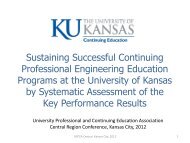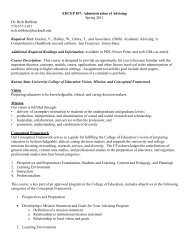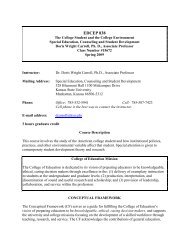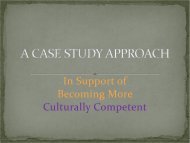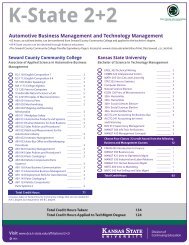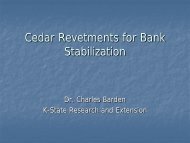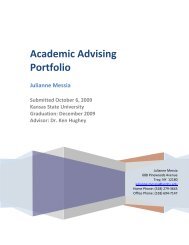David Freitag – KSU Capstone Project - K-State Division of ...
David Freitag – KSU Capstone Project - K-State Division of ...
David Freitag – KSU Capstone Project - K-State Division of ...
Create successful ePaper yourself
Turn your PDF publications into a flip-book with our unique Google optimized e-Paper software.
Academic Advising Portfolio<br />
<strong>David</strong> A. <strong>Freitag</strong><br />
Submitted September 19, 2010<br />
Kansas <strong>State</strong> University<br />
Graduation: December 2010<br />
Advisor: Dr. Ken Hughey<br />
<strong>David</strong> A. <strong>Freitag</strong><br />
5100 N. Camino del Lazo<br />
Tucson, AZ 85750<br />
<strong>Freitag</strong>@ksu.edu<br />
Home Phone: (520) 529-‐4819<br />
Office Phone: (520) 206-‐4808
TABLE OF CONTENTS<br />
Introduction........................................................................................................................................................3<br />
Résumé ................................................................................................................................................................4<br />
Philosophy <strong>of</strong> Academic Advising <strong>State</strong>ment ......................................................................................6<br />
Portfolio Option 1: Case Studies<br />
Case Study 1: Ellen Brewer............................................................................................................11<br />
Case Study 2: Javier Villaverde ....................................................................................................17<br />
Case Study 3: Robert Clarke..........................................................................................................23<br />
2
Introduction<br />
This portfolio contains a personal résumé, my philosophy <strong>of</strong> academic advising, and<br />
three case studies. The résumé is intended for a job search as an academic advisor. My<br />
philosophy <strong>of</strong> academic advising is a living statement that will undoubtedly be updated<br />
periodically as I gain experience in higher education. Does a published philosophy have<br />
meaning in the world? “Research suggests that there is a relatively high consistency<br />
between an advisor’s stated philosophy <strong>of</strong> advising and the behaviors he or she actually<br />
utilizes” (Creamer & Scott, 2000, p. 342). By periodically reviewing my philosophy I will<br />
reinforce my commitment to providing effective academic advising.<br />
The three case studies in this Academic Advising Portfolio demonstrate my<br />
knowledge and competencies regarding:<br />
• advising strategies for institutional advising programs and individual academic<br />
advising,<br />
• theories <strong>of</strong> learning, student development, and career development,<br />
• potential multicultural influences on advising relationships, and<br />
• the needs and characteristics <strong>of</strong> special groups <strong>of</strong> students.<br />
References<br />
Creamer, E. G., & Scott, D. W. (2000). Assessing individual advisor effectiveness. In V. N.<br />
Gordon & W. R. Habley (Eds.), Academic advising: A comprehensive handbook (pp.<br />
339-‐348). San Francisco, CA: Jossey-‐Bass.<br />
3
Objective<br />
<strong>David</strong> A. <strong>Freitag</strong><br />
5100 North Camino del Lazo, Tucson, AZ 85750<br />
520.529.4819<br />
dafreitag@pima.edu<br />
To attain a position as an academic advisor at an institution <strong>of</strong> higher education.<br />
Experience<br />
IT Principal Analyst, Pima Community College Tucson, AZ<br />
October 2009 <strong>–</strong> present<br />
• Led and managed the Curriculum Approvals workflow project.<br />
• Led project and performed business analysis for Flexible Registration s<strong>of</strong>tware<br />
implementation project.<br />
• Provided consulting, advice, and training to the school’s user community.<br />
• Provided support for the SunGard Banner s<strong>of</strong>tware.<br />
Student Services Specialist, Pima Community College Tucson, AZ<br />
August 2008 <strong>–</strong> October 2009<br />
• Met with students one-‐on-‐one and in group orientation sessions.<br />
• Worked with students on educational programs, classes, and methods for achieving<br />
success.<br />
• Advised students working towards Associates Degrees, Certificates, and general<br />
education requirements for transfer.<br />
• Completed degree checks and created Educational Plans with students.<br />
• Advised undecided students and helped students create educational plans.<br />
• Advised first generation students, international students, ESL students, and students<br />
from multi-‐cultural backgrounds.<br />
• Advised socio-‐economically and culturally diverse populations.<br />
• Advised students on academic probation.<br />
• Advised students on financial probation and helped with their financial aid appeals.<br />
• Completed many <strong>of</strong> the Federal Student Aid online training modules.<br />
• Met with more than 4000 students.<br />
Teaching Assistant, University <strong>of</strong> Arizona Tucson, AZ<br />
August 2006 <strong>–</strong> July 2007<br />
• Taught Micros<strong>of</strong>t Excel to 2100 students.<br />
4
• Presented orientation sessions in a large auditorium for 250 students at a time.<br />
• Advised and tutored students during <strong>of</strong>fice hours.<br />
• Created and graded homework and exams, posted grades, enforced academic<br />
integrity cases.<br />
• More than 95% <strong>of</strong> students passed the MS-‐Excel Specialist Certification Exam.<br />
Director, Indus International, Inc. San Francisco, CA<br />
October 1993 <strong>–</strong> December 2003<br />
• Director <strong>of</strong> Architecture, Portals, and Release Delivery for the PassPort product at<br />
Indus International, an international s<strong>of</strong>tware company with products for nuclear<br />
and electric utilities and large manufacturers.<br />
• Managed a budget <strong>of</strong> $3.5 million for the s<strong>of</strong>tware development and maintenance<br />
work <strong>of</strong> more than 30 programmers, systems analysts, quality assurance analysts,<br />
technical writers, and technical support personnel.<br />
• Coordinated the work <strong>of</strong> multiple departments to deliver high quality s<strong>of</strong>tware.<br />
• Successfully delivered more than forty s<strong>of</strong>tware product releases to customers.<br />
• Lead speaker at the company’s User Conference sessions on Quality Assurance.<br />
Education<br />
• M.S. Academic Advising, Administration December 2010<br />
Kansas <strong>State</strong> University, Manhattan, KS<br />
• Graduate Certificate in Academic Advising July 2009<br />
Kansas <strong>State</strong> University, Manhattan, KS<br />
• B.S. Computer Science December 1982<br />
Middle Tennessee <strong>State</strong> University, Murfreesboro, TN,<br />
Other Accomplishments<br />
• Active member <strong>of</strong> the National Academic Advising Association since 2008.<br />
• Published an article on advising in the September 2008 NACADA’s Academic<br />
Advising Today newsletter describing academic advisors as knowledge workers.<br />
• Developed s<strong>of</strong>tware for NACADA members to administer the Academic Advising<br />
Inventory Survey.<br />
• Developed s<strong>of</strong>tware for NACADA members to perform advising program<br />
assessments using the CAS standards and guidelines for academic advising<br />
programs.<br />
• Certified Micros<strong>of</strong>t Specialist in Word, Excel and PowerPoint.<br />
5
Philosophy <strong>of</strong> Academic Advising<br />
As an academic advisor, my primary mission is to help students successfully<br />
navigate through their academic careers while exploring their educational and career<br />
options. My advising sessions are designed to be educational experiences where students<br />
connect who-‐they-‐are-‐now with what-‐they-‐are-‐learning and who-‐they-‐want-‐to-‐become<br />
(Pettay, 2007).<br />
My <strong>of</strong>fice is a comfortable environment conducive to relaxation and the<br />
encouragement <strong>of</strong> candid conversation. During my advising sessions I listen actively and<br />
without judgment while identifying the most effective method for communicating with the<br />
specific student in front <strong>of</strong> me. I identify special needs and make appropriate referrals.<br />
As an advising pr<strong>of</strong>essional, I accept the responsibilities for advisors as stated in the<br />
NACADA <strong>State</strong>ment <strong>of</strong> Core Values (NACADA, 2004). It is also my responsibility as an<br />
academic advisor to be fully knowledgeable about the informational, relational, and<br />
conceptual components <strong>of</strong> academic advising (Habley, 1995).<br />
The informational component includes a solid grounding in knowledge about the<br />
institution, the academic catalog, policies and procedures, degree requirements, and<br />
campus resources. Communicating accurate and timely information to students is a<br />
necessary condition <strong>of</strong> being an effective academic advisor. Successfully meeting the<br />
informational needs <strong>of</strong> students, sometimes through prescriptive methods, is fundamental<br />
to the advising relationship. Until the basic needs <strong>of</strong> a student have been met it is useless to<br />
attempt to work with a student on their higher-‐level developmental needs (Fielstein,<br />
1994).<br />
6
The relational component includes the one-‐to-‐one relationship and trust between<br />
advisor and advisee which is critical to the advising process and to the student’s<br />
satisfaction with the advising session and the institution. Without productive one-‐on-‐one<br />
relationships with students, building a level <strong>of</strong> mutual trust, I will not be able to effectively<br />
address my students’ developmental needs.<br />
A thorough understanding <strong>of</strong> the conceptual component will enable me to increase<br />
the effectiveness <strong>of</strong> my advising sessions. A commitment to lifelong learning is essential in<br />
improving my conceptual knowledge <strong>of</strong> the pr<strong>of</strong>ession <strong>of</strong> academic advising and my<br />
knowledge <strong>of</strong> the theories <strong>of</strong> student development and career development. Although there<br />
are no recognized unifying theories <strong>of</strong> academic advising, knowledge <strong>of</strong> theories relevant to<br />
academic advising are still useful because they reduce a complicated interpersonal<br />
situation to an understandable number <strong>of</strong> elements (Creamer, 2000).<br />
Bringing the three components <strong>of</strong> academic advising together, after the basic<br />
informational needs <strong>of</strong> students are met, I help students understand the relationship<br />
between their university course work, their intended career, and their desired lifestyle. I<br />
challenge students’ unrealistic or unreasonable beliefs. I encourage students to exercise<br />
their problem-‐solving and decision-‐making skills to advance their level <strong>of</strong> personal<br />
development. I encourage students to turn their talents into strengths and use those<br />
strengths to achieve their personal and career goals (Schreiner, 2005). Through my<br />
knowledge and understanding <strong>of</strong> the framework <strong>of</strong> the three components <strong>of</strong> academic<br />
advising, I help students realize their educational plans and dreams. It is my passion to help<br />
each student, through their education, to become the person they want to be.<br />
7
Theories <strong>of</strong> academic advising and student development are useful to know, but,<br />
even so, they have their shortcomings. Since reality is more complex than any theory can<br />
fully describe, advisors must synthesize multiple theories to craft a multilayered response<br />
to a student’s specific situation (Creamer, 2000). An “understanding <strong>–</strong> <strong>of</strong> anything <strong>–</strong> always<br />
requires a field, a gestalt, <strong>of</strong> background knowledge which provides analogues, taxonomies,<br />
definitions, and precursor concepts” (Hendey, 1999). A thorough knowledge <strong>of</strong> theories<br />
about student and career development, and approaches to academic advising, will provide<br />
a solid foundation for my advising sessions and will enable me to maintain a full toolbox <strong>of</strong><br />
ideas and techniques I can use with students as appropriate.<br />
As an academic advisor, I consider myself as not only an advisor, but also an<br />
academic. I take an academic interest in the process <strong>of</strong> advising students; I take an<br />
academic interest in the administration and assessment <strong>of</strong> advisors; I take an academic<br />
interest in improving the quality and effectiveness <strong>of</strong> my advising and the advising<br />
performed at my institution. I am an advisor-‐practitioner, but I also strive to be an advisor-‐<br />
scholar.<br />
I have a curiosity about advising and participate in research projects to learn more<br />
about the advising process and environment. I encourage an institutional culture <strong>of</strong><br />
evidence-‐based decision-‐making. I promote and encourage a pr<strong>of</strong>essional climate within<br />
academic advising and throughout the institution (Troxel, 2008).<br />
Through thoughtful interactions during academic advising process I can teach each<br />
student I see how to successfully navigate their educational career and ultimately help<br />
them to become the person they want to be.<br />
8
References<br />
Creamer, D. G. (2000). Use <strong>of</strong> theory in academic advising. In V. N. Gordon & W. R. Habley<br />
(Eds.), Academic advising: A comprehensive handbook (pp. 18-‐34). San Francisco, CA:<br />
Jossey-‐Bass.<br />
Crookston, B. (1972). A developmental view <strong>of</strong> academic advising as teaching. Journal <strong>of</strong><br />
College Student Personnel, 13, 12-‐17.<br />
Fielstein, L. (1994). Developmental versus prescriptive advising: Must it be one or the<br />
other? NACADA Journal, 14(2), 76-‐79.<br />
Frost, S. H. (2000). Historical and philosophical foundations for academic advising. In V. N.<br />
Gordon, & W. R. Habley (Eds.), Academic advising: A comprehensive handbook (pp. 3-‐<br />
17). San Francisco, CA: Jossey-‐Bass.<br />
Habley, W. R. (1995). Advisor training in the context <strong>of</strong> a teaching enhancement center. In<br />
R. E. Gleenen & F. N. Vowell (Eds.), Academic advising as a comprehensive campus<br />
process (pp. 75-‐79). Manhattan, KS: National Academic Advising Association.<br />
Hendey, W. G. (1999). Developmental advising: A practical view. The Mentor: An Academic<br />
Advising Journal. Retrieved from http://www.psu.edu/dus/mentor/990115wh.htm<br />
NACADA. (2004). NACADA statement <strong>of</strong> core values <strong>of</strong> academic advising. Retrieved from the<br />
NACADA Clearinghouse <strong>of</strong> Academic Advising Resources website:<br />
http://www.nacada.ksu.edu/Clearinghouse/AdvisingIssues/Core-‐values.htm<br />
Pettay, R. F. (2007). Making the transition from prescriptive advising to advising as<br />
teaching. Academic Advising Today, 30(2). Retrieved from<br />
http://www.nacada.ksu.edu/AAT/documents/30_2.pdf<br />
9
Schreiner, L. A. (2005). Strengths-‐based advising: A new lens for higher education. NACADA<br />
Journal, 25(2), 20-‐29.<br />
Troxel, W. G. (2008). Assessing the effectiveness <strong>of</strong> the advising program. In V. N. Gordon,<br />
W. R. Habley, & T. J. Grites (Eds.), Academic advising: A comprehensive handbook (2 nd<br />
ed., pp. 386-‐394). San Francisco, CA: Jossey-‐Bass.<br />
10
Case Study 1: Ellen Brewer<br />
Ellen Brewer has come to the Community College’s Advising Office to complete a<br />
graduation application to receive an Associate’s Degree at the end <strong>of</strong> the next semester. She<br />
has one semester left before she transfers to the local university with an Associate <strong>of</strong> Arts<br />
degree, a degree that is designed to prepare students to transfer into university majors in<br />
the liberal arts, humanities, social and behavioral sciences and education. Ellen is an<br />
excellent student, a member <strong>of</strong> the debate team, and has a GPA <strong>of</strong> 3.85.<br />
As you review Ellen’s gradation application she admits to having no idea which<br />
subject she wants to major in at the university and is feeling pressure from her parents to<br />
make a decision. Ellen has never held a job and does not understand the connection<br />
between her educational course <strong>of</strong> study and her career options. She communicates that<br />
being undecided about a future career is beginning to make her dread her final semester<br />
instead <strong>of</strong> being able to celebrate achieving an educational milestone.<br />
Response to Case Study 1<br />
What began as a simple request to sign a graduation application has turned into an<br />
opportunity for her advisor to help Ellen begin to explore her life goals and interests in<br />
preparation for beginning a career exploration. Advisors should always be aware that any<br />
student contact can result in a different type <strong>of</strong> interaction. “Every advising contact is a<br />
precious opportunity for meaningful interaction” (Kuh, 2000, p. 79) and conversations with<br />
students can easily turn to subjects different from the original topic.<br />
Ellen is undecided in choosing a course <strong>of</strong> study, but she does not appear to be<br />
chronically indecisive or postponing a decision. She just has not yet begun to think about<br />
her career. On the continuum from “very decided, somewhat decided, unstable decided,<br />
11
tentatively undecided, developmentally undecided, seriously undecided, and chronically<br />
indecisive” (Steele & McDonald, 2000, pp. 146-‐147), Ellen describes herself as undecided<br />
about her future career plans. Students at a different location on the continuum may<br />
require different advising approaches. Due to her limited experience with working, Ellen is<br />
truly not aware <strong>of</strong> the career possibilities she has and appears to lack enough knowledge<br />
about herself, possible careers, and the education required for various careers to be able to<br />
make an informed decision.<br />
Students <strong>of</strong>ten see being undecided as a problem, but advisors should encourage<br />
students to view being undecided not as a problem, but as the beginning <strong>of</strong> an exciting<br />
developmental journey. Some students may understand that, but many students will need<br />
help in understanding there is a process they can follow to help them decide upon a major<br />
and a career path. Just knowing there is a path to follow can lend comfort to students who<br />
are feeling stress from being undecided about a major.<br />
In 1992 Gordon proposed a model for the career development process that included<br />
four elements: self-‐knowledge, educational knowledge, occupational knowledge, and<br />
decision-‐making knowledge. “The goal <strong>of</strong> this model is to provide a framework to help<br />
students gather the kind <strong>of</strong> information needed to make realistic and satisfying choices”<br />
(Steele & McDonald, 2000, pp. 147-‐148).<br />
To explore her career options, Ellen first needs to identify and understand her<br />
abilities, aptitudes, interests, and personal limitations. Then she needs to understand the<br />
type <strong>of</strong> education that is required to be qualified for different types <strong>of</strong> jobs and careers,<br />
what jobs are possible, what the work environment is like for those jobs, and what the<br />
actual day-‐to-‐day work is like (Niles & Harris-‐Bowlsbey, 2005). After Ellen has gathered<br />
12
and thoughtfully considered this information, she should be prepared to make a decision. If<br />
the student cannot make a decision after a period <strong>of</strong> reflection and enough time to consider<br />
the options, she may be chronically indecisive and should be referred to a counselor.<br />
Advising Strategies<br />
Ellen has several options for her career exploration <strong>–</strong> she can set up a series <strong>of</strong><br />
meetings with her advisor to perform career advising and learn more about the “complex<br />
relationships that exist between academic experiences and career fields” (Gore & Metz,<br />
2008, p. 104) , she can work with a career counselor in the Career Center to take “formal<br />
psychological assessment <strong>of</strong> career-‐related variables” (Gore & Metz, 2008, p. 104), and she<br />
could enroll in a class in career decision-‐making. The Career Center at Ellen’s educational<br />
institution can provide a variety <strong>of</strong> self-‐assessment tools to help her understand her<br />
interests, abilities, and values. She can also volunteer in areas she is interested in or<br />
perform job shadowing and informational interviewing to learn more about various<br />
careers and the day-‐to-‐day responsibilities <strong>of</strong> someone working there.<br />
Ellen’s advisor can help her understand her educational options in relation to<br />
possible careers, and the Career Center can help her expand her knowledge <strong>of</strong> possible<br />
careers based upon her interests. A career advisor, a career counselor, or an instructor <strong>of</strong> a<br />
career decision-‐making class may use a workbook such as Gordon and Sear’s (2004)<br />
Selecting a College Major to provide a framework to organize and manage the career<br />
exploration process.<br />
To determine how much Ellen already knows about career planning and the world<br />
<strong>of</strong> work, she could take the Career Development Inventory (Niles & Harris-‐Bowlsbey,<br />
2005). At the Career Center Ellen could take one or more interest inventories, such as the<br />
13
Strong Interest Inventory, to identify her interests. While computer-‐based interest<br />
inventories and career guidance systems can be very useful to students, Ellen should be<br />
encouraged to talk with her advisor or a career counselor to understand what is being<br />
suggested by computer s<strong>of</strong>tware such as the Internet-‐based DISCOVER program which will<br />
assess her interests, abilities, and values.<br />
Connected to DISCOVER, the World-‐<strong>of</strong>-‐Work Map is useful to initiate discussions<br />
about the types <strong>of</strong> careers available and how each career type primarily works with data,<br />
people, ideas, or things. This enables students to begin linking their personal preferences to<br />
specific types <strong>of</strong> careers and enables them to begin focusing on the areas they are most<br />
interested in. To further focus her energies, using Holland’s Theory <strong>of</strong> Vocational<br />
Personalities and Environments will help Ellen identify her personality type and the type <strong>of</strong><br />
work people who are like her enjoy.<br />
Career Development<br />
Holland’s theory enables students to match their personality style to occupational<br />
titles and classifies personality and environments into six types: realistic, investigative,<br />
artistic, social, enterprising, and conventional (Creamer, 2000). The theory asserts that<br />
people will prefer jobs where they can work with other people who are similar to<br />
themselves and will be happier and more satisfied in employment environments that<br />
enable them to use their skills and abilities and are similar in type to their personality.<br />
Various instruments exist to assess the student’s personality type: The Strong Interest<br />
Inventory, the Vocational Preference Inventory (VPI), and the Self-‐Directed Search (SDS),<br />
and others (Evans, Forney, & Guido-‐DiBrito, 1998). A career counselor in the Career Center<br />
can help her with these instruments.<br />
14
It would be helpful if her advisor could determine Ellen’s level <strong>of</strong> differentiation,<br />
identity, and congruence. “A differentiated person has interests that are characteristic <strong>of</strong><br />
mainly one type,” identity refers to “the ‘clarity and stability’ <strong>of</strong> the person’s goals,<br />
interests, and abilities,” and congruence refers to “the degree <strong>of</strong> ‘match’ between a person<br />
and an environment” (Evans et al., 1998, pp. 230-‐231). If Ellen’s interests are not<br />
characteristic <strong>of</strong> the personality type suggested by her Holland code, the advisor should<br />
discuss with her why that might be the case. Any student who is considering a career that is<br />
highly incongruent with their personality type should be questioned about their reasoning.<br />
Using the Holland Classification system to discover a student’s personality type is not the<br />
end <strong>of</strong> a career exploration, but only the beginning <strong>of</strong> a conversation with the student.<br />
Summary<br />
By being aware <strong>of</strong> her personality type as identified by her Holland code, Ellen can<br />
increase her potential to select a satisfying career. By using a specific career exploration<br />
framework with Ellen, giving her a career exploration roadmap to follow, her advisor will<br />
be able to provide Ellen with needed information, developmental tasks, and the<br />
encouragement she needs as she navigates through her academic career and continues in<br />
her career exploration process.<br />
15
References<br />
Creamer, D. G. (2000). Use <strong>of</strong> theory in academic advising. In V. N. Gordon & W. R. Habley<br />
(Eds.), Academic advising: A comprehensive handbook (pp. 18-‐34). San Francisco, CA:<br />
Jossey-‐Bass.<br />
Evans, N. J., Forney, D. S., & Guido-‐DiBrito, F. (1998). Student development in college:<br />
Theory, research, and practice. San Francisco, CA: Jossey-‐Bass.<br />
Gordon, V. N., & Sears, S. J. (2004). Selecting a college major: Exploration and decision<br />
making (5th ed.). Upper Saddle River, NJ: Pearson Prentice Hall.<br />
Gore, P. A., Jr., & Metz, A. J. (2008). Advising for career and life planning. In V. N. Gordon, W.<br />
R. Habley & T. J. Grites (Eds.), Academic advising: A comprehensive handbook (2 nd ed.,<br />
pp. 103-‐117). San Francisco, CA: Jossey-‐Bass.<br />
Kuh, G. D. (2008). Advising for Student Success. In V. N. Gordon, W. R. Habley, & T. J. Grites<br />
(Eds.), Academic advising: A comprehensive handbook (2 nd ed., pp. 68-‐84). San<br />
Francisco, CA: Jossey-‐Bass.<br />
Niles, S. G., & Harris-‐Bowlsbey, J. (2005). Career development interventions in the 21st<br />
century (2 nd ed.). Upper Saddle River, NJ: Merrill-‐Prentice Hall.<br />
Steele, G., & McDonald, M. (2000). Advising students in transition. In V. N. Gordon & W. R.<br />
Habley (Eds.), Academic advising: A comprehensive handbook (pp. 144-‐161). San<br />
Francisco, CA: Jossey-‐Bass.<br />
16
Case Study 2: Javier Villaverde<br />
In February a student named Javier came into the Community College’s advising<br />
center and asked to meet with an advisor. After a few minutes, it is clear to you that Javier<br />
cannot articulate a clear reason why he is here today, but he is frustrated and did not know<br />
where else to go. He has many questions about college that he hopes you can help him with.<br />
Javier is half Native American with a Hispanic father and attended high school on a<br />
nearby reservation. He is a first generation college student and was successful academically<br />
in high school. His family and friends, while initially supportive <strong>of</strong> his desire to attend<br />
college, are not so supportive now that he has been less than successful in his first semester<br />
and are encouraging him to drop out and return home.<br />
Javier is discouraged with his grades <strong>–</strong> mostly Cs with one D in College Algebra<br />
which he is repeating this semester. He describes being frustrated with reading and<br />
rereading his textbooks without improving his retention <strong>of</strong> the information. He did not<br />
have to study much in high school and, although he knew he would have to study more in<br />
college, he is disappointed with his results in college so far. He is beginning to think he is<br />
not smart enough for college.<br />
Response to Case Study 2<br />
Javier is clearly a student at risk, but it is a good sign that he is seeking help instead<br />
<strong>of</strong> just disappearing from the campus. “Every advising contact is a precious opportunity for<br />
meaningful interaction” (Kuh, 2008, p. 79) and effective academic advising at this specific<br />
time in Javier’s life will be critical to helping him stay in school and pursue an education.<br />
Javier is underperforming in college when compared to his previous academic history, and<br />
has described poor study habits. Javier is not receiving familial support for continuing his<br />
17
education and is questioning his decision to attend college. Helping Javier handle his lack <strong>of</strong><br />
support from his family, and improving his study skills, will be critical in enabling Javier to<br />
be more successful and stay enrolled in school.<br />
Multicultural and First Generation Considerations<br />
As a first generation student who does not have anyone in his family who has<br />
attended college who can advise him, Javier needs to be shown specific techniques for<br />
improving his studying. Javier is experiencing several issues common to students new to<br />
college and to first generation students in particular. Like many first generation students,<br />
Javier is seeking help from academic advising not only for academic advice, but also for “the<br />
guidance considered necessary to navigate day-‐to-‐day campus life” (Sickles, 2004). It will<br />
be very important for Javier to feel that his advisor cares about his future (Sickles, 2004)<br />
since his advisor may be the only person he knows who is actively encouraging him to stay<br />
in school.<br />
Because many multicultural students are most concerned with specific issues and<br />
not developmental concerns, it may be most effective to use a more directive, prescriptive<br />
approach to add structure to the advising relationship with Javier (Cornett-‐DeVito &<br />
Reeves, 1999). The first priority <strong>of</strong> the advising relationship will be to work to remedy his<br />
immediate concerns by identifying the behaviors and skills he needs to develop to<br />
maximize his potential for success. It is essential for students to learn information such as<br />
“knowing where to study, how to concentrate when studying, and how to form study<br />
groups (Rivas, 1988)” (Brown & Rivas, 1995, p. 124). Perhaps even more important for<br />
Javier because <strong>of</strong> his cultural background than it might be for some other students, it will<br />
be important for Javier to, “be able to measure and experience, in concrete, tangible ways,<br />
18
(his) progress toward goal achievement” (Brown & Rivas, 1995, p. 124). An advisor can<br />
help Javier with identifying specifically what he needs to learn and what resources are<br />
available to him for achieving his goals <strong>–</strong> in this case a better academic performance as<br />
evidenced by higher grades and higher satisfaction with his efforts at learning the material.<br />
Because <strong>of</strong> his poor academic results and a lack <strong>of</strong> support from his family, Javier<br />
appears to be questioning his decision to attend college. Many Native American students<br />
feel pressure to quit school and return home even if they are doing well in school. Although<br />
as educators we believe education is important, advisors should be aware how their<br />
worldview affects their interactions with students who may have a different worldview<br />
(Cunningham, 2003). Doing poorly in school can be used as an easy excuse to drop out if<br />
not challenged by an advisor.<br />
Native American students may also have to respond to “American Indian”<br />
stereotypes, feelings <strong>of</strong> intellectual inferiority, and feeling more like a “Native American<br />
student” rather than just a “student.” They may see the campus as hostile and not<br />
supportive <strong>of</strong> their needs (Clark & Kalionzes, 2008).<br />
Advisors should be comfortable with diversity and with advising students different<br />
from themselves. To better advise Native American students advisors should strive to<br />
understand the student’s family and tribal background, build trust with the student,<br />
understand identity development <strong>of</strong> minority students, develop multicultural<br />
competencies, and make an attempt to be in the student’s world by seeing students outside<br />
the formal advising environment (Clark & Kalionzes, 2008). It is important for advisors to<br />
“use specific advising approaches and demonstrate cultural awareness and competency to<br />
19
work successfully” with students <strong>of</strong> color such as Native American students (Clark &<br />
Kalionzes, 2008, p. 222).<br />
Advising Strategies<br />
Native American students may feel that their community and tribal goals should<br />
take precedence over their individual goals (Clark & Kalionzes, 2008), but advisors should<br />
encourage students from reservations to see how their personal goals can complement<br />
tribal goals. Javier needs to hear that returning to the reservation with a degree will enable<br />
him to be a leader and an effective role model for others. It would be particularly helpful<br />
for Javier to meet with a peer advisor with a similar Native American background to<br />
discuss the influences in his life that are encouraging him to return to the reservation.<br />
To improve his connection to the school, Javier should be encouraged to join one or<br />
more study groups, and a student club or organization such as a Native American Student<br />
Association. Every school has number <strong>of</strong> organizations that would welcome a new member.<br />
Making new friends who support his efforts to attend school would give Javier a new<br />
perspective on his educational career.<br />
Without improving his study skills Javier will continue to be at risk <strong>of</strong> performing<br />
poorly in his classes and dropping out <strong>of</strong> school. An advisor can help Javier with learning<br />
specific study skills, but he should be encouraged to enroll in a study skills course to<br />
explore the topic in more depth and to learn more techniques than can be taught in a few<br />
advising sessions. Such a class will teach Javier the importance and methods <strong>of</strong> using an<br />
active reading strategy such as questioning, predicting, organizing, elaborating, and<br />
summarizing the material to improve retention <strong>of</strong> the information. The class will highlight<br />
the importance <strong>of</strong> organizing the material, creating internal connections within the<br />
20
material, recognizing external connections to the material, creating practice tests, and<br />
practicing taking those tests under test conditions.<br />
Summary<br />
Javier is at risk for attrition due to his poor academic performance and lack <strong>of</strong><br />
support from home, but these are issues that can be overcome or handled effectively with<br />
the help <strong>of</strong> an advisor. He can learn new study skills and enroll in a study skills class, he can<br />
meet with a peer advisor to learn he is not alone, and he can join a study group or student<br />
organization and make new friends who will support his decision to attend college. By<br />
taking a positive and constructive approach with Javier, his advisor will be able to provide<br />
Javier with information and the encouragement he needs to continue his academic career.<br />
21
References<br />
Brown, T., & Rivas, M. (1995). Pluralistic advising: Facilitating the development and<br />
achievement <strong>of</strong> first-‐year students <strong>of</strong> color. In M. Upcraft & G. Kramer (Eds.), First-<br />
year academic advising: Patterns in the present, pathways to the future (pp. 121-‐137).<br />
Columbia, SC: University <strong>of</strong> South Carolina, National Resource Center for the<br />
Freshman Year Experience & Students in Transition.<br />
Clark, E. C., & Kalionzes, J. (2008). Advising students <strong>of</strong> color and international students. In<br />
V. N. Gordon, W. R. Habley, & T. J. Grites (Eds.), Academic advising: A comprehensive<br />
handbook (2 nd ed., pp. 204-‐225). San Francisco, CA: Jossey-‐Bass.<br />
Cornett-‐DeVito, M., & Reeves, K. (1999). Preparing students for success in a multicultural<br />
world: Faculty advisement and intercultural communication. NACADA Journal, 19<br />
(1), 35-‐44.<br />
Cunningham, L. A. (2003). Multicultural awareness. Retrieved from the NACADA<br />
Clearinghouse <strong>of</strong> Academic Advising Resources website:<br />
http://www.nacada.ksu.edu/Clearinghouse/AdvisingIssues/Multicultural.htm<br />
Kuh, G. D. (2008). Advising for student success. In V. N. Gordon, W. R. Habley, & T. J. Grites<br />
(Eds.), Academic advising: A comprehensive handbook (2 nd ed., pp 68-‐84). San<br />
Francisco, CA: Jossey-‐Bass.<br />
Sickles, A. R. (2004). Advising first-generation students. Retrieved from the NACADA<br />
Clearinghouse <strong>of</strong> Academic Advising Resources website:<br />
http://www.nacada.ksu.edu/Clearinghouse/AdvisingIssues/1st_Generation.htm<br />
22
Case Study 3: Robert Clarke<br />
Robert is a sophomore at the state university majoring in Business. His GPA is a<br />
respectable 3.0 after his freshman year, but that is much lower than his high school GPA. He<br />
needs his GPA to be much higher to be accepted into the Lewis College <strong>of</strong> Management next<br />
year. He is a member <strong>of</strong> the theater construction crew and enjoys creating sets for the<br />
school’s theater company, although he expresses disdain for the actors and doesn’t really<br />
have any friends in the theater.<br />
During your meeting Robert expresses frustration with the teaching methods <strong>of</strong> his<br />
instructors who seem to focus entirely on theory without consideration <strong>of</strong> its application to<br />
the real world. Robert says he wants to ‘get his hands dirty’ with the material, not talk<br />
about it all day. As a consequence <strong>of</strong> his frustration, Robert is beginning to doubt his ability<br />
to keep up with his peers who seem to him to enjoy talking about theories without actually<br />
doing anything with them. He has had several outbursts during class discussions where he<br />
pleaded for everyone to stop talking about the same thing over and over again.<br />
Response to Case Study 3<br />
Robert is a good student, but he is not performing academically as well as he could<br />
because he does not understand his own preferred learning style and the teaching styles <strong>of</strong><br />
his instructors. With a little help and advice from his advisor in helping him understand<br />
himself and the academic environment, Robert will be able to improve his academic<br />
performance and gain more satisfaction from his time spent at college.<br />
Learning Theory<br />
Kolb’s Theory <strong>of</strong> Experiential Learning describes a four-‐stage cycle <strong>of</strong> learning<br />
where knowledge is created through concrete experience, reflective observation, abstract<br />
23
conceptualization, and active experimentation. “Concrete experience forms the basis <strong>of</strong><br />
observation and reflection. These observations are in turn used to develop one’s ideas,<br />
including generalizations and theories. From this development <strong>of</strong> ideas, new implications<br />
for action can be discerned” (Evans, Forney, & Guido-‐DiBrito, 1998, p. 209). Advisors can<br />
help students understand this learning cycle to help their students be more effective<br />
learners.<br />
Kolb’s theory also defines four learning styles which are related to the theory’s cycle<br />
<strong>of</strong> learning. Through conversations with the student over one or more advising sessions, it<br />
may be possible to determine which <strong>of</strong> the four learning styles Robert prefers:<br />
• Assimilators, who learn best through examining sound logical theories,<br />
• Convergers, who learn best through practical applications <strong>of</strong> theory,<br />
• Accommodators, who learn best through ‘hands on’ experiences, and<br />
• Divergers, who learn best by observing and collecting information.<br />
It is undoubtedly useful for students to know their own primary learning style, but it<br />
is just as important for students to understand its weaknesses as well. For example,<br />
accommodator can find themselves “caught up in activity for activity’s sake, engaged in<br />
insignificant efforts” (Evans et al., 1998, p. 211). Advisors should caution the student about<br />
locking themselves in a specific learning style <strong>–</strong> the student will feel more personal<br />
fulfillment during the course <strong>of</strong> their life when they learn to use other learning styles as<br />
appropriate (Evans et al., 1998).<br />
Student Development Theory<br />
Chickering and Reisser’s revised Theory <strong>of</strong> Identity Development identifies seven<br />
vectors <strong>of</strong> development that students move through <strong>–</strong> although not necessarily in order, at<br />
24
similar rates, or without repeating. The seven vectors are developing competence,<br />
managing emotions, moving through autonomy toward interdependence, developing<br />
mature interpersonal relationships, establishing identity, developing purpose, and<br />
developing integrity (Evans et al., 1998).<br />
Developing competence means increasing the student’s capacities in intellectual,<br />
physical, manual, and interpersonal areas. Managing emotions means developing the<br />
student’s “ability to recognize and accept emotions, as well as to appropriately express and<br />
control them” (Evans et al., 1998, p. 38). The vector <strong>of</strong> moving through autonomy towards<br />
interdependence means not looking to others for continual validation and reassurance.<br />
Developing more mature personal relationships means developing “the capacity for<br />
healthy and lasting intimate relationships with partners and close friends” (Evans et al.,<br />
1998, p. 39). Establishing identity includes “comfort with body and appearance, comfort<br />
with gender and sexual orientation, a sense <strong>of</strong> one’s social and cultural heritage” (Evans et<br />
al., 1998, pp. 39-‐40) and positive self-‐acceptance and self-‐esteem. The vector <strong>of</strong> developing<br />
purpose means developing clear vocational goals and strong interpersonal commitments.<br />
Developing integrity means developing and following a personal value system (Evans et al.,<br />
1998).<br />
Chickering and Reisser’s revised Theory <strong>of</strong> Identity Development is a useful<br />
framework for advisors to help understand their students’ level <strong>of</strong> personal development<br />
and how they can help their students grow and mature. Advisors should be aware there are<br />
several instruments for assessing a student’s progression through the seven vectors which<br />
include the Student Development Task and Lifestyle Inventory and the Iowa Student<br />
Development Inventories (Evans et al., 1998).<br />
25
Advising Strategies<br />
Robert is an Accommodator in terms <strong>of</strong> Kolb’s learning styles. He is someone who<br />
enjoys and learns best with hands-‐on experience, so it is no mystery why he is frustrated<br />
with pr<strong>of</strong>essors who are assimilators and enjoy the discussion <strong>of</strong> theory for its own sake.<br />
His advisor can help Robert understand not only his own learning style, but also the<br />
teaching styles <strong>of</strong> his instructors. It is likely Robert will be surprised that his instructors<br />
have preferred styles just as he does and that they are not trying to make the subject<br />
difficult for him <strong>–</strong> that is just the way they think. This insight alone should enable Robert to<br />
work with his instructors in a more mature manner resulting in a closer teacher-‐student<br />
relationship.<br />
Three <strong>of</strong> Chickering’s vectors <strong>–</strong> developing competence, managing emotions, and<br />
developing mature interpersonal relationships <strong>–</strong> can be the framework through which his<br />
advisor can understand Robert’s issues. Robert had been competent in high school as<br />
demonstrated by his good grades, but he is frustrated by his average grades in college.<br />
Because Robert focuses too much on his weaknesses, it could be very effective for<br />
his advisor to focus on identifying and working with his strengths. “Strengths-‐based<br />
advising is predicated on students’ natural talents and is used to build their confidence<br />
while motivating them to acquire the knowledge base and skills necessary for college-‐level<br />
achievement” (Schreiner, 2005, p. 22). This is exactly what Robert needs. Once Robert<br />
recognizes his strengths it would be useful to explore how his strengths could be used to<br />
develop personal competence to be more successful in college.<br />
Working through the managing emotions vector, an advisor could help Robert come<br />
up with strategies for channeling his frustrations with his fellow students and instructors<br />
26
into more productive areas. For example, instead <strong>of</strong> pleading for everyone to stop talking<br />
about a subject, he could <strong>of</strong>fer to summarize the conversation so the group could move on<br />
to the next topic. This would require Robert to be more involved in the group’s<br />
conversation so he would be able to condense everyone’s thoughts into a short summary.<br />
Like many students, Robert is experiencing a self-‐imposed feeling <strong>of</strong> isolation. He<br />
should be encouraged to talk with other students in the theater company and get to know<br />
them as people. Through interaction with others Robert will have the opportunity to learn<br />
to appreciate the differences and the similarities between himself and his fellow students.<br />
Summary<br />
Knowledge <strong>of</strong> theories applicable to academic advising will enable Robert’s advisor<br />
to reduce his complicated situation to the essential elements that need to be addressed<br />
(Creamer, 2000). Focusing on these elements, singly or in combination, can be used to<br />
suggest directions Robert should take towards gaining the outcomes he desires for his<br />
educational career. Robert’s advisor, with the proper education and motivation, can be an<br />
integral part <strong>of</strong> Robert’s education.<br />
27
References<br />
Creamer, D. G. (2000). Use <strong>of</strong> theory in academic advising. In V. N. Gordon & W. R. Habley<br />
(Eds.), Academic advising: A comprehensive handbook (pp. 18-‐34). San Francisco, CA:<br />
Jossey-‐Bass.<br />
Evans, N. J., Forney, D. S., & Guido-‐DiBrito, F. (1998). Student development in college:<br />
Theory, research, and practice. San Francisco, CA: Jossey-‐Bass.<br />
Schreiner, L. A. (2005). Strengths-‐based advising: A new lens for higher education. NACADA<br />
Journal, 25(2), 20-‐29.<br />
28


